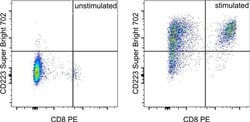Learn More
Invitrogen™ CD223 (LAG-3) Monoclonal Antibody (eBioC9B7W (C9B7W)), Super Bright™ 702, eBioscience™, Invitrogen™
Rat Monoclonal Antibody
Especificaciones
| Antígeno | CD223 (LAG-3) |
|---|---|
| Clon | eBioC9B7W (C9B7W) |
| Aplicaciones | Flow Cytometry |
| Clasificación | Monoclonal |
| Conjugado | Super Bright 702 |
Descripción
Description: The J105 monoclonal antibody reacts with the human PD-1 (programmed death-1), a 55 kDa member of the CD28 immunoglobulin superfamily. PD-1 contains the immunoreceptor tyrosine-based inhibitory motif (ITIM) and plays a key role in peripheral tolerance and autoimmune disease. PD-1 is expressed predomitly on activated T and B lymphocytes. Two novel members of the B7 family have been identified as the PD-1 ligands, PD-L1 (B7-H1) and PD-L2 (B7-DC). Evidence reported to date suggests overlapping functions for these two PD-1 ligands and their constitutive expression on some normal tissues and upregulation on activated antigen-presenting cells. Costaining experiments suggest that eBioJ105 recognizes a different epitope than MIH4 (cat. 11-9969-42). Applications Reported: This eBioJ105 (J105) antibody has been reported for use in flow cytometric analysis. Applications Tested: This eBioJ105 (J105) antibody has been pre-diluted and tested by flow cytometric analysis of stimulated normal human peripheral blood cells. This may be used at 5 μL (1.0 μg) per test. A test is defined as the amount (μg) of antibody that will stain a cell sample in a final volume of 100 μL. Cell number should be determined empirically but can range from 10^5 to 10^8 cells/test. Super Bright 702 is a tandem dye that can be excited with the violet laser line (405 nm) and emits at 702 nm. We recommend using a 710/50 bandpass filter.
LAG-3 is a 70-kDa surface glycoprotein belonging to the Ig superfamily with homology to CD4. LAG-3 binds to MHC class II with higher affinity than CD4 and is thought to be involved in the negative regulation of T cell activation and homeostatic proliferation. Surface expression of LAG-3 has been reported on activated T cells (including regulatory T cells) and NK cells. CD8+ T cells usually express LAG-3 at significantly higher levels than CD4+ T cells. Coexpression of LAG-3 and CD49b has been proposed to identify human and mouse Type 1 regulatory T cells (Tr1 cells).Especificaciones
| CD223 (LAG-3) | |
| Flow Cytometry | |
| Super Bright 702 | |
| Rat | |
| Mouse | |
| 16768 | |
| Primary | |
| 4°C, store in dark, DO NOT FREEZE! |
| eBioC9B7W (C9B7W) | |
| Monoclonal | |
| Liquid | |
| RUO | |
| Q61790 | |
| IgG1 κ | |
| Affinity chromatography | |
| Antibody |
Proporcione sus comentarios sobre el contenido del producto rellenando el siguiente formulario.



